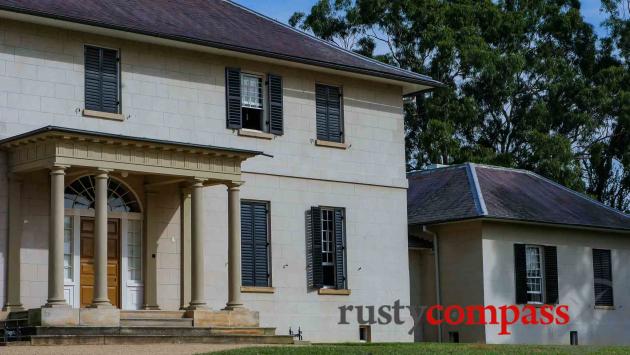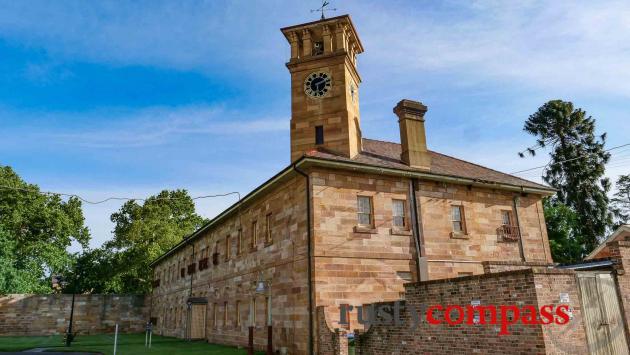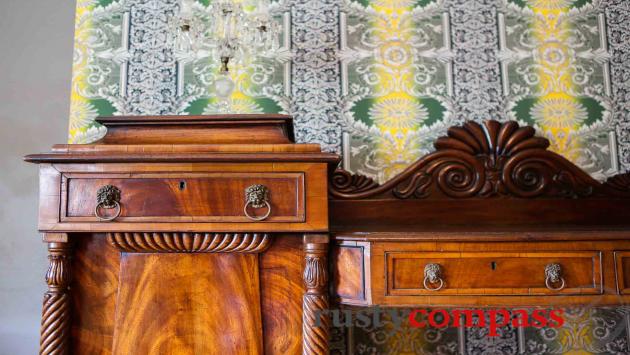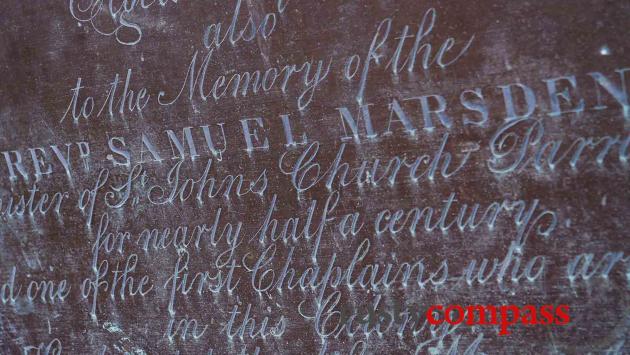Parramatta self-guided heritage walk and cycling tour -
brief itinerary and travel tips
Visitors to Parramatta can arrive by train, ferry or car from the centre of Sydney. The ferry ride from Circular Quay is especially relaxing with spectacular views of Sydney Harbour, the Parramatta River. Those who travel by ferry have the option to stop at historic Cockatoo Island on the way to or from Parramatta. Bike storage is straightforward on the ferry too (depending on crowds - better than the train).
In late 2024, a new light rail service opened in Parramatta that makes heritage touring easier than ever. The new rail lines make all Parramatta's heritage locations accessible. Now this entire tour outlined below can be easily managed combining walking and light rail.
OPTION 1 - Take the River Cat to Parramatta and the train back
The Parramatta River Cat is a convenient catamaran commuter service that operates between Circular Quay (the ferry terminal in central Sydney) and Parramatta. The service gives you the full Sydney Harbour and Parramatta River experience and can be combined with a visit to historic Cockatoo Island.
All the references in this itinerary are listed in more detail below.
From Parramatta passenger dock you can walk (or ride) to Elizabeth Farm and visit the other two historic residences there - Hambledon Cottage and Experiment Farm. Then walk back towards Parramatta River and take the long (20 - 30 minutes) walk along the River to Old Government House. You can then walk to St John's Cemetery and St John's Church. From the church, take the light rail and visit the Female Orphan School (Whitlam Institute) and the Female Factory before heading back to Parramatta Station.
OPTION 2 - Take a train or drive to Parramatta.
The centre of Parramatta is easily accessed by rail from central Sydney rail stations. Allow between 30 - 45 minutes.
To St John's Church Paramatta
If you start at Parramatta Station, walk through the shiny new towers of Parramatta Square, towards St John’s Church - it's around 5 minutes walk. Parramatta's historic 1881 Town Hall will be the first heritage site you encounter. Opposite Parramatta Town Hall is the oldest continuous place of Christian worship in Australia.
To St John’s Cemetery - 10 mins walk
From St John's Church, head west towards St John's Cemetery. From 1790, this is by far the oldest colonial burial ground in Australia. It also contains the oldest grave.
To Old Government House - 10 mins walk
Old Government House is the oldest public building in Australia. It's managed by the National Trust and it's well worth exploring inside.
To Female Factory 30 mins walk
Hambledon Cottage and Experiment Farm each right beside Elizabeth Farm
NOTE:
Parramatta's heritage destinations below mostly open irregular hours. Elizabeth Farm - one of the most important, only opens two days a week. There seems to be little or no coordination between various heritage destinations. Check times and note that an enjoyable visit - especially by bicycle - can be had even when things are closed.
GETTING AROUND IN PARRAMATTA
Most of these locations can be visited over a casual day or half day of walking or cycling. Parramatta's new light rail also makes all of these locations very accessible without worrying about a car.
St John’s Cathedral
Where - towards Parramatta Park and Government House in Parramatta Square
Church services have been held at the site of St John’s Cathedral since the late 1790s, making it the oldest continuous place of Christian worship in Australia.
In 1803, a makeshift church was replaced by a more permanent structure. The two distinct towers, still standing today, were added in 1818, at the instigation of Lady Macquarie, wife of Governor
Lachlan Macquarie. The rest of the original structure was demolished in 1852 and replaced by the present sandstone cathedral. The transepts were added in 1883.
Reverend Samuel Marsden, “the flogging parson”, one of best known and most controversial figures in the early colony, was chaplain at St John’s.
In addition to his duties as the senior clergyman in the colony from 1800 to his death in 1838, Marsden served as a magistrate in Parramatta. He is remembered for his harsh and frequent administration of the lash.
There are plaques on the cathedral walls commemorating the lives of Marsden and his wife, as well as other prominent figures in early colonial life.
Other items of interest at the cathedral include a Thwaites and Reed clock from 1821 and a pipe organ that was, when acquired in 1861, the largest in Australia.

Photo: Mark Bowyer St John's Church, Parramatta
St John's Cemetery
Where - 5 minutes walk from St John's Church enroute to Parramatta Park and Government House
Established in 1790, St John’s Cemetery is the oldest surviving European burial ground in Australia. It contains the graves, many unmarked, of at least fifty of those who arrived in Sydney aboard the First Fleet in January 1788. The First Fleet was the British colonising fleet commanded by Captain Arthur Phillip, from which the penal colony was established and the seizure of the lands of Australia’s First Peoples began. As remarkable as the cemetery’s historical links is its apparent neglect. Parramatta and Sydney invest little in telling the stories of the cemetery and it is often overrun by weeds.
Perhaps the most remarkable of the graves at St John’s is that of Henry Dodd. Buried in 1791, Dodd’s is the oldest grave in situ in Australia. He was Captain Arthur Phillip’s personal servant and played an important role in the development of agriculture around Parramatta.
Other big names in early colonial history resting at St John’s Cemetery include the flogging Parson, Samuel Marsden, botanist Charles Fraser, D’Arcy Wentworth and more.

Photo: Mark Bowyer Samuel Marsden's grave - St John's Cemetery, Parramatta

Photo: Mark Bowyer St John's Cemetery
Old Government House
Where - In Parramatta Park - 15 minutes walk from Parramatta Train Station
World Heritage Listed Old Government House, is the oldest surviving public building in Australia, and one of the country’s most important heritage buildings. Built by convicts between 1799 and 1816, it demonstrates the key role played by Parramatta in the early development of the colony.
The first 10 Governors of New South Wales used the Georgian Old Government House as a country residence for over 7 decades. One of the most influential of them, Lachlan Macquarie, preferred the Parramatta location to his Sydney residence. It was Macquarie and his wife Elizabeth, who most influenced the Palladian building we see today, in renovations they commissioned in 1815.
Old Government House is the major historical landmark in the beautiful 86ha grounds of Parramatta Park. Its immediate views, looking down to the Parramatta River, are remarkably similar to those of the early 19th century. Views beyond Parramatta Park, span the fast changing Parramatta City skyline.
The exhibition of furniture inside Government House is in keeping with the periods of its use by governors and includes original pieces from the Macquarie’s time in residence.
All the furnishings and decorations are genuine period pieces from the collection of the National Trust.

Photo: Mark Bowyer Government House, Parramatta

Photo: Mark Bowyer Period furnishing - Old Government House, Parramatta
Female Factory Parramatta
No place better demonstrates Parramatta's steadfast resistance to embracing its historical substance than the Female Factory precinct in North Parramatta. A place of incarceration of women for nearly two centuries, the Female Factory is also home to some of Sydney's best preserved Georgian and later architecture.
Around 13% of convicts shipped to the penal colony of Sydney were women. From the 1820s, many of them were sent to the Female Factory - a place of incarceration and work for convict women. In any other place in Australia, this would be an iconic convict history destination. Not Parramatta. But you'll be surprised by the quality of the heritage structures here and the green setting.
The good news is that in the past couple of years, a major restoration of the heritage precinct has taken place. And there's now a cafe and a co-working space at the site. There are plans for a museum too.

Photo: Mark Bowyer Female Factory Parramatta - Australia's oldest and largest female convict ruins - perfect heritage and cultural development

Photo: Mark Bowyer Female Factory Parramatta - Australia's oldest and largest female convict ruins are left unknown.
Elizabeth Farm - the Macarthur Residence 1793
Where - East of Parramatta station - 15 minutes walk. Close by Hambledon Cottage and Experiment Farm.
Hidden away in a typical suburban Parramatta street, Elizabeth Farm, built in 1793, is Australia’s oldest surviving European dwelling. Its other claim to fame is that it was built by John Macarthur, one of the most influential and controversial figures in early Australian colonial history.
Macarthur and his wife may be some of the most interesting and most written about figures in the early colony. But the oldest standing building in Australia only opens its doors to visitors for a few hours a week on a couple of days. It’s a spectacular failure of storytelling by Parramatta and Museums of History NSW.
Elizabeth Farm is named after Macarthur’s wife - herself a formidable character in the early colony. John Macarthur, a British army officer, was both a pioneer of Australia’s wool industry and a major player in early colonial intrigue. He was a co-conspirator in the 1808 Rum Rebellion that saw the overthrow of Governor William Bligh by the New South Wales Corp - the only successful political coup in Australian history (if you exclude those prosecuted by the Royal representatives in 1932 and 1975).
Macarthur took a personal interest in the developing cottage and his time in India influenced the decision to build a shady bungalow with a deep verandah. The expansive manicured colonial era gardens are a highlight with trees that date back to the establishment of the original homestead.
Elizabeth Farm was saved from demolition in the early 1970s and in 1977 became the first house in New South Wales to be protected under a conservation order.
Visitors experience a family friendly “hands on” museum. All the furnishings are reproductions so visitors are free to sit on the verandah and freely interact with the house and its furnishings.

Photo: Mark Bowyer The superb building and grounds of Elizabeth Farm, Parramatta. The old Macarthur family residence.

Photo: Mark Bowyer Country kitchen - Elizabeth Farm, Parramatta
Hambledon Cottage
Where - right by Elizabeth Farm and Experiment Farm
Built in 1824, Hambledon Cottage, was part of John Macarthur’s Elizabeth Farm estate and is only a few hundred metres from Elizabeth Farm cottage.
Hambledon was used as additional accommodation by the Macarthur family and their friends. Best known resident was Penelope Lucas, governess to the Macarthur daughters.
Set on two acres of land that includes trees that date back to its construction, Hambledon is an excellent example of colonial Georgian style architecture, and has some outstanding original features,
including Australian cedar joinery, an ironbark floor and original kitchen fittings.
All of the furnishings are genuine period pieces and some have a special connection with the early colony. Reverend Samuel Marsden’s desk and Governor Fitzroy’s bed are memorable pieces.
The cottage is built of sandstock brick and is a house museum - giving visitors an accurate sense of a colonial cottage in the early to mid 19th century.

Photo: Mark Bowyer Hambledon Cottage, Parramatta

Photo: Mark Bowyer Hambledon Cottage, Parramatta
Experiment Farm Cottage
Where - right by Elizabeth Farm and Hambledon Cottage
Experiment Farm Cottage sits on one of the most important parcels of land in the founding of the colony of New South Wales.
It was here that Governor Phillip issued the first land grant to former convict, James Ruse, in 1789. Ruse went on to become a pioneer of agriculture and an exemplar of the capacity of emancipated
convicts to contribute to the development of a self-sustaining colony.
Ruse’s success marked the beginnings of the colony’s westward advance and the dispossession of local Indigenous tribes.
In 1793, Ruse sold his farm to surgeon John Harris. Harris built the existing cottage on the site in the mid 1830s. It is one of the oldest standing residences in Australia and includes many original features.
The interior of the cottage is decorated in1830s style with antiques from the National Trust collection. Experiment Farm Cottage was acquired by the National Trust in 1961. Surrounding land has been added since then, creating a sense of the setting and vistas of the original cottage.
The old cellar houses a permanent exhibition telling the story of the surrounding area from indigenous occupation through to the present.
Experiment Farm is located a few hundred metres from Elizabeth Farm and Hambledon Cottage.

Photo: Mark Bowyer Experiment Farm, Parramatta

Photo: Mark Bowyer Experiment Farm, Parramatta - period interiors
Why is Parramatta so important in Australian history?
The Burramattagal people of the Parramatta area prospered on fertile lands by the river for thousands of years prior to colonisation. The tragic frontier wars between invader and invaded escalated in the Parramatta area. Aboriginal warriors Pemulwuy and Windradyne had important encounters around Parramatta. So much essential but mostly unknown and ignored Australian history took place here.
The conditions that brought prosperity to the Dharug people around Parramatta for centuries, made settlement here attractive to invading British colonials in the 1700s. Parramatta's fertile soils rescued the starving colonial project
Some of the largest characters in early Australian colonial history - Macarthur, Macquarie, Marsden, Wentworth and many others, all spent time shaping the early penal colony from Parramatta.
Parramatta saving the starving penal colony
The early years of the penal colony around Sydney Cove were grim. The soil around Sydney harbour couldn't support the agricultural needs of the new settlement. The invaders didn't understand the soil nor the climate. The food situation was desperate and the new colony was on the brink of collapse.

Painting: Augustus Earle Annual meeting of native tribes Parramatta 1820s
The search for better agricultural land took Governor Phillip upriver to Parramatta in late 1788. After surveying the river the soil and the terrain, a decision was taken to have a shot at raising crops in what would become the second major colonial settlement. The first successful crops were grown in and around Parramatta in the 1790s and the area played an important role in securing the penal settlement's food needs and viability.
The local Dharug people soon worked out that the colonial appetite for land knew no bounds and there was little regard for traditional ownership and interests. Frontier conflict erupted.
From Parramatta, agricultural opportunities, especially wool, pushed settlers further west and beyond the Blue Mountains. Frontier conflict escalated. Eventually, agriculture and mining underwrote the seizure of the entire continent from its traditional owners. You could say that Parramatta was the launchpad for the westward expansion of the agricultural colony and the dispossession and misery it caused.

Photo: Mark Bowyer St John's Church, Australia's oldest continuous place of Christian worship
Parramatta is almost silent about this extraordinary history. As you wander around the new city of skyscrapers, it feels like it may have been run by property developers for half a century or more. And property interests have played a part in ensuring that history and heritage never obstructed the the developer wrecking ball. Even in 2021, a cute piece of Parramatta heritage, Willow Grove, was demolished despite community uproar (read the blog for more).
There have been many heritage losses over the decades but Parramatta retains an impressive collection of historic buildings. - though they're in need of some proper storytelling and coordination.
Parramatta’s heritage story is incoherent. Most of the big stories go untold. The heritage sites don't seem to collaborate on opening hours, storytelling or anything much.
I grew up near Parramatta so it's familiar territory. Like other Sydneysiders, I knew little of Parramatta’s importance in Australian history until the past decade, when I began to take a fresh interest in Sydney’s past.
Some highly committed local community heritage groups keep the wheels turning. It's too much for volunteers. But they've ensured the heritage sites are cared for and protected. If you're interested in Australian history, a visit to Parramatta is a must. It's a great way to spend a day.
Parramatta’s food scene
Check out Parramatta’s food scene while you’re in the neighbourhood. Church St, Parramatta’s main street, is packed with delicious international eateries serving up Middle Eastern, Asian and South Asian cuisine. Nearby, Harris Park is the centre of Indian cuisine in Sydney (a short walk from Elizabeth Farm).










There are no comments yet.